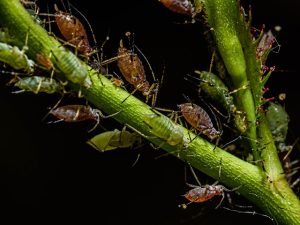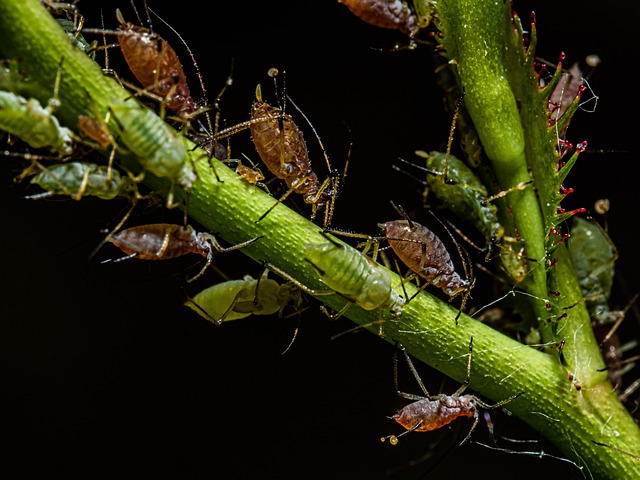Whether you’re dealing with aphids, slugs, caterpillars, or spider mites, understanding their habits and knowing how to control them is essential for maintaining a vibrant garden.

This guide covers some of the most common garden pests, their identifying features, and proven methods to control them. Additionally, we’ll explore prevention strategies that reduce the likelihood of infestations, ensuring your plants remain strong and pest-free.
Common Garden Pests and How to Control Them
1. Aphids
Identification: Aphids are small, soft-bodied insects, usually green but sometimes yellow, brown, red, or black. They cluster on new growth, stems, and the undersides of leaves, sucking sap and weakening plants.
Damage:
- Leaves curl, yellow, or stunt in growth.
- Sticky honeydew secretion promotes sooty mold.
- Can transmit plant viruses.
Control Methods:
- Natural Predators: Introduce ladybugs, lacewings, or parasitic wasps.
- Spray Treatment: Use insecticidal soap or a mixture of water and a few drops of dish soap.
- Water Blast: A strong spray of water dislodges aphids from plants.
2. Slugs and Snails
Identification: Slugs are soft-bodied, while snails have a hard shell. Both leave slimy trails and chew irregular holes in leaves, often targeting young seedlings.
Damage:
- Devour tender leaves, stems, and fruits overnight.
- Prefer moist, shady environments.
Control Methods:
- Beer Traps: Bury a shallow container of beer to attract and drown them.
- Copper Barriers: Copper tape repels them with a mild electric charge.
- Handpicking: Remove them in the evening when they’re most active.
- Diatomaceous Earth: Sprinkle around plants to dehydrate and kill them.
3. Caterpillars
Identification: These are the larvae of butterflies and moths, usually green or brown, varying in size.
Damage:
- Chew large holes or skeletonize leaves.
- Some species bore into fruits (e.g., tomato hornworms).
Control Methods:
- Hand Removal: Pick off caterpillars and drop them in soapy water.
- Bacillus thuringiensis (Bt): A natural bacteria that targets caterpillars without harming beneficial insects.
- Bird Attraction: Encourage birds that feed on caterpillars.
4. Spider Mites
Identification: Tiny, red, or yellow pests that create fine webbing on plants. They thrive in hot, dry conditions.
Damage:
- Suck plant juices, causing stippling and yellowing leaves.
- Severe infestations lead to leaf drop and plant death.
Control Methods:
- Water Spray: Blast plants with water to dislodge mites.
- Neem Oil: Acts as a natural miticide.
- Predatory Mites: Introduce Phytoseiulus persimilis to eat spider mites.
5. Whiteflies
Identification: Small, white, moth-like insects that swarm when disturbed.
Damage:
- Suck sap, weakening plants and spreading diseases.
- Honeydew secretion leads to sooty mold.
Control Methods:
- Yellow Sticky Traps: Attract and trap adult whiteflies.
- Insecticidal Soap: Effective against nymphs and adults.
- Natural Predators: Ladybugs and lacewings feed on whiteflies.
Prevention Strategies for a Pest-Free Garden
While controlling pests is important, prevention is the best long-term strategy. A healthy garden ecosystem naturally resists infestations.
1. Maintain Healthy Soil
- Nutrient-rich soil promotes strong plant growth, making them less susceptible to pests.
- Use compost and organic matter to improve soil structure.
2. Practice Diverse Planting
- Monocultures attract pests; diverse planting confuses them.
- Mix flowers, herbs, and vegetables to create a balanced ecosystem.
3. Companion Planting
- Marigolds: Deter nematodes and repel aphids.
- Basil: Repels whiteflies and mosquitoes.
- Garlic & Chives: Discourage slugs and aphids.
4. Proper Watering Techniques
- Water early in the day to reduce fungal growth.
- Avoid overwatering, which attracts slugs and snails.
5. Regular Monitoring
- Inspect plants weekly for early signs of pests or use fungicides.
- Remove infected leaves or plants promptly.
6. Use Physical Barriers
- Row Covers: Protect plants from flying insects.
- Netting: Keeps birds and larger pests away.
- Cloches: Shield young seedlings from pests.
7. Crop Rotation
- Prevents soil-borne pests from becoming established.
- Rotate plant families each season (e.g., don’t plant tomatoes in the same spot yearly).
8. Encourage Beneficial Insects
- Plant nectar-rich flowers (e.g., dill, fennel, yarrow) to attract pollinators and predators.
- Avoid broad-spectrum pesticides that kill helpful insects.
9. Use Organic Pesticides Wisely
- Neem Oil: Disrupts pest life cycles.
- Insecticidal Soap: Effective against soft-bodied insects.
- Diatomaceous Earth: Kills crawling insects without chemicals.
Conclusion
A pest-free garden is achievable with the right knowledge and strategies. By identifying common pests early and using targeted control methods, you can minimize damage without resorting to harsh chemicals. Prevention—through healthy soil, companion planting, and encouraging beneficial insects—creates a resilient garden that naturally resists infestations.
Regular monitoring and quick action are key. Whether you’re handpicking slugs, spraying aphids with soapy water, or using row covers to protect plants, a proactive approach ensures your garden remains lush and productive. With these techniques, you can enjoy a thriving, pest-free garden all season long.
